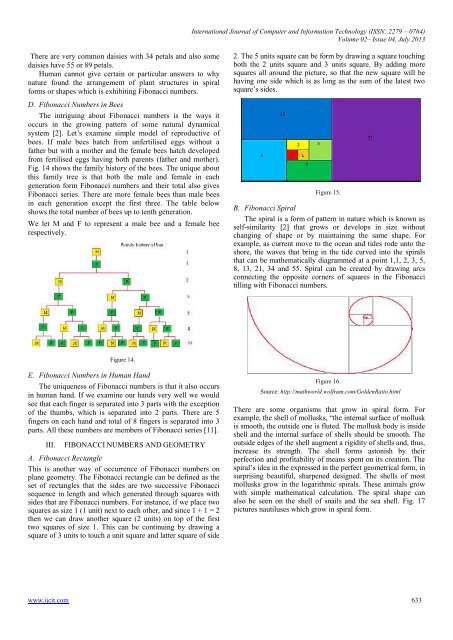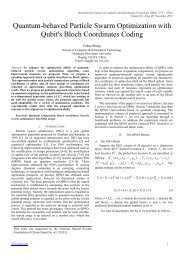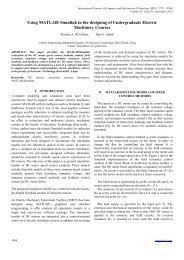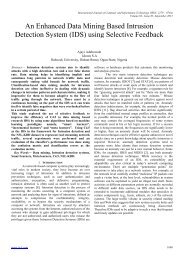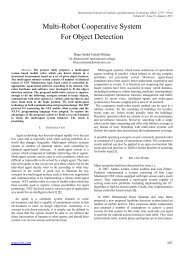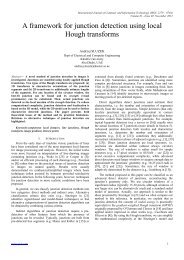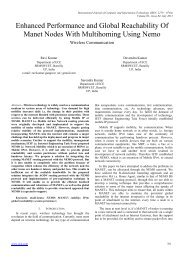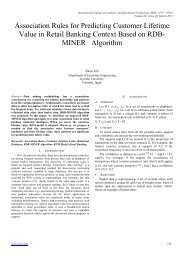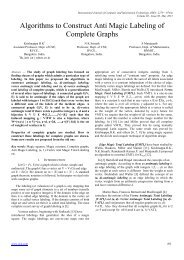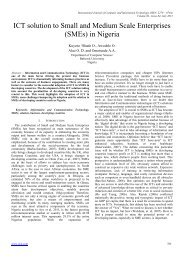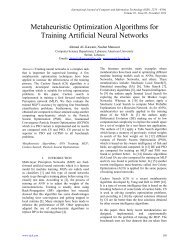Fibonacci Numbers and Golden Ratio in Mathematics and Science
Fibonacci Numbers and Golden Ratio in Mathematics and Science
Fibonacci Numbers and Golden Ratio in Mathematics and Science
Create successful ePaper yourself
Turn your PDF publications into a flip-book with our unique Google optimized e-Paper software.
International Journal of Computer <strong>and</strong> Information Technology (ISSN: 2279 – 0764)<br />
Volume 02– Issue 04, July 2013<br />
There are very common daisies with 34 petals <strong>and</strong> also some<br />
daisies have 55 or 89 petals.<br />
Human cannot give certa<strong>in</strong> or particular answers to why<br />
nature found the arrangement of plant structures <strong>in</strong> spiral<br />
forms or shapes which is exhibit<strong>in</strong>g <strong>Fibonacci</strong> numbers.<br />
D. <strong>Fibonacci</strong> <strong>Numbers</strong> <strong>in</strong> Bees<br />
The <strong>in</strong>trigu<strong>in</strong>g about <strong>Fibonacci</strong> numbers is the ways it<br />
occurs <strong>in</strong> the grow<strong>in</strong>g pattern of some natural dynamical<br />
system [2]. Let’s exam<strong>in</strong>e simple model of reproductive of<br />
bees. If male bees hatch from unfertilised eggs without a<br />
father but with a mother <strong>and</strong> the female bees hatch developed<br />
from fertilised eggs hav<strong>in</strong>g both parents (father <strong>and</strong> mother).<br />
Fig. 14 shows the family history of the bees. The unique about<br />
this family tree is that both the male <strong>and</strong> female <strong>in</strong> each<br />
generation form <strong>Fibonacci</strong> numbers <strong>and</strong> their total also gives<br />
<strong>Fibonacci</strong> series. There are more female bees than male bees<br />
<strong>in</strong> each generation except the first three. The table below<br />
shows the total number of bees up to tenth generation.<br />
We let M <strong>and</strong> F to represent a male bee <strong>and</strong> a female bee<br />
respectively.<br />
2. The 5 units square can be form by draw<strong>in</strong>g a square touch<strong>in</strong>g<br />
both the 2 units square <strong>and</strong> 3 units square. By add<strong>in</strong>g more<br />
squares all around the picture, so that the new square will be<br />
hav<strong>in</strong>g one side which is as long as the sum of the latest two<br />
square’s sides.<br />
Figure 15.<br />
B. <strong>Fibonacci</strong> Spiral<br />
The spiral is a form of pattern <strong>in</strong> nature which is known as<br />
self-similarity [2] that grows or develops <strong>in</strong> size without<br />
chang<strong>in</strong>g of shape or by ma<strong>in</strong>ta<strong>in</strong><strong>in</strong>g the same shape. For<br />
example, as current move to the ocean <strong>and</strong> tides rode unto the<br />
shore, the waves that br<strong>in</strong>g <strong>in</strong> the tide curved <strong>in</strong>to the spirals<br />
that can be mathematically diagrammed at a po<strong>in</strong>t 1,1, 2, 3, 5,<br />
8, 13, 21, 34 <strong>and</strong> 55. Spiral can be created by draw<strong>in</strong>g arcs<br />
connect<strong>in</strong>g the opposite corners of squares <strong>in</strong> the <strong>Fibonacci</strong><br />
till<strong>in</strong>g with <strong>Fibonacci</strong> numbers.<br />
Figure 14.<br />
E. <strong>Fibonacci</strong> <strong>Numbers</strong> <strong>in</strong> Human H<strong>and</strong><br />
The uniqueness of <strong>Fibonacci</strong> numbers is that it also occurs<br />
<strong>in</strong> human h<strong>and</strong>. If we exam<strong>in</strong>e our h<strong>and</strong>s very well we would<br />
see that each f<strong>in</strong>ger is separated <strong>in</strong>to 3 parts with the exception<br />
of the thumbs, which is separated <strong>in</strong>to 2 parts. There are 5<br />
f<strong>in</strong>gers on each h<strong>and</strong> <strong>and</strong> total of 8 f<strong>in</strong>gers is separated <strong>in</strong>to 3<br />
parts. All these numbers are members of <strong>Fibonacci</strong> series [11].<br />
III.<br />
FIBONACCI NUMBERS AND GEOMETRY<br />
A. <strong>Fibonacci</strong> Rectangle<br />
This is another way of occurrence of <strong>Fibonacci</strong> numbers on<br />
plane geometry. The <strong>Fibonacci</strong> rectangle can be def<strong>in</strong>ed as the<br />
set of rectangles that the sides are two successive <strong>Fibonacci</strong><br />
sequence <strong>in</strong> length <strong>and</strong> which generated through squares with<br />
sides that are <strong>Fibonacci</strong> numbers. For <strong>in</strong>stance, if we place two<br />
squares as size 1 (1 unit) next to each other, <strong>and</strong> s<strong>in</strong>ce 1 + 1 = 2<br />
then we can draw another square (2 units) on top of the first<br />
two squares of size 1. This can be cont<strong>in</strong>u<strong>in</strong>g by draw<strong>in</strong>g a<br />
square of 3 units to touch a unit square <strong>and</strong> latter square of side<br />
Figure 16.<br />
Source: http://mathworld.wolfram.com/<strong>Golden</strong><strong>Ratio</strong>.html<br />
There are some organisms that grow <strong>in</strong> spiral form. For<br />
example, the shell of mollusks, “the <strong>in</strong>ternal surface of mollusk<br />
is smooth, the outside one is fluted. The mollusk body is <strong>in</strong>side<br />
shell <strong>and</strong> the <strong>in</strong>ternal surface of shells should be smooth. The<br />
outside edges of the shell augment a rigidity of shells <strong>and</strong>, thus,<br />
<strong>in</strong>crease its strength. The shell forms astonish by their<br />
perfection <strong>and</strong> profitability of means spent on its creation. The<br />
spiral’s idea <strong>in</strong> the expressed <strong>in</strong> the perfect geometrical form, <strong>in</strong><br />
surpris<strong>in</strong>g beautiful, sharpened designed. The shells of most<br />
mollusks grow <strong>in</strong> the logarithmic spirals. These animals grow<br />
with simple mathematical calculation. The spiral shape can<br />
also be seen on the shell of snails <strong>and</strong> the sea shell. Fig. 17<br />
pictures nautiluses which grow <strong>in</strong> spiral form.<br />
www.ijcit.com 633


